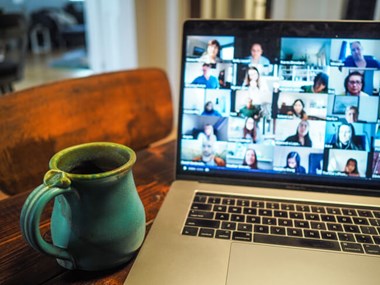
The rapid onset and intensity of the COVID-19 pandemic has required some radical changes in most areas of our professional lives, including a chance to update traditional approaches to learning. Virtual learning is the use of remote video conferencing software, web-based learning management systems and other digital technology to teach. Six months ago, it was considered by many to be a bit of a fad. Today it is an essential tool to remain interconnected. Those who are unable or unwilling to engage are being left behind.
Is it a fad?
Although many yearn for a return to life as it was, virtual learning will be here to stay. It is less expensive compared with face-to-face teaching and it releases learners from time and distance restraints [1]. Blended learning, virtual and face to face, can offer a wide range of flexibility to allow learners to access resources wherever and at any time and use the face to face elements for those activities which are more difficult to replicate.
What can be taught online?
A dispiriting amount of educational content has been low level information purveyance, both online and face to face. Learners can read a webpage or book. It’s the practical tips, tricks, wisdom and hidden pearls they need from us to be a safe and effective professional. Whether you are teaching one or 5000, the first step is to identify your learners and define what they need to be able to DO when your interaction is complete? Is it around knowledge, practical skills, judgement or professional issues? Only then can you decide how best to achieve the learning outcome. Is it a large group of over 50 where a webinar might be more appropriate than a meeting at which teachers and learners can be more interactive?
How can we develop the new skills?
Clinicians can learn how to use online platforms and acquire a wider understanding of the applications [2]. While most concerns have centred on how learning activities may successfully transit from face-to-face to remote delivery, little attention has been given to how educators can be supported [3]. However, necessity being the mother of invention, we have seen remote training programmes and events proliferate over a matter of weeks, with entire congresses for thousands shifting online. Those used to live face to face events have reinvented themselves as online teachers, with increasing levels of confidence and impact.

What next?
Once you have decided on the aim, audience and method, if you can share the organisation with others, whilst one is responsible for content, another can run the technical side of the session. A moderator will also ensure smooth running and help individuals who run into trouble.
You might invest in some initial help with the technical side, but you will find this relatively straightforward after some guidance with selection of software. There are plenty of products available, many of them free or cheap, so there is no need to spend a fortune. Underpinning whatever you do with strong educational principles is essential. A clear structure and visual aids which are both visible and helpful, are crucial.
Potential pitfalls
It is easy for learners to succumb to distractions at home. Most learners decide whether you are worth listening to within a few seconds. Fumbling with the technical side or flowery social chat will waste that opportunity. Eye contact can be even more challenging online, as it is not intuitive to look at the camera, but can be learned. Voice modulation needs to be greater than at face-to-face events. Your conversation voice can sound dull. Modulation including pitch, pauses and speed will need some rehearsal. Our micro-expressions will also need some work. We are used to seeing teachers talk at a distance but up close, the camera magnifies facial expression. Finally, watch out for connection. Wi-Fi may be too risky. A wired network connection is faster and more reliable.
Tips to make online events work
- Test technology beforehand, including camera / video, Wi-Fi and software
- Make sure nobody is streaming movies through the same Wi-Fi
- Be punctual, as its distracting when people join the group late
- Minimise distractions
- Mute when you aren’t speaking
- Make sure everyone is in a quiet area free from unnecessary distractions
- Don’t stare at your phone while others are speaking
- Don’t work on other tasks during the session
- Turn off all notifications and make sure your mobile is on silent
- Don’t interrupt others when they’re speaking or speak over them
- Raise your e-hand if you want to ask a question
- Write questions or comments in the chat column
- Respect confidentiality
Conclusions
In our new world of learning, the legacy models are probably gone for good. Technology enhanced learning can be more accessible and less expensive, but it won’t bypass the requirement for strong educational foundations. It also should not replace face-to-face teaching entirely. Teaching practical skills and patient examination remotely is more challenging, but not impossible. The value of establishing professional networks and relationships cannot be underestimated and would suffer in a purely virtual teaching programme. As with all teaching and learning, preparation is the key. We can all engage with virtual education, as long as we have the motivation to learn new skills. BUT, four notes of caution, DON’T:
- Waste it on purveying information only
- Let the technical tail wag the dog
- Chuck money at the initiative
- Bypass strong educational underpinnings
References
1. Payne GW. The role of blended learning in 21st century medical education:current trends and future directions. In: Kitchenham A (ed): Blended learning across disciplines: models for implementation. Hershey: IGI Global; 2011:132–46.
2. El Boghdady M, Ewalds-Kvist BM, Alijani A. A review of online platforms in training and surgical education. Eur Surg 2019;51:41-8.
3. Eva KW. Medical education adaptations: really good stuff for educational transition during a pandemic. Med Educ 2020;54(6):494.
COMMENTS ARE WELCOME






